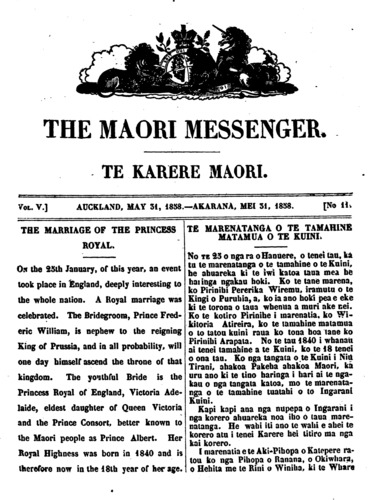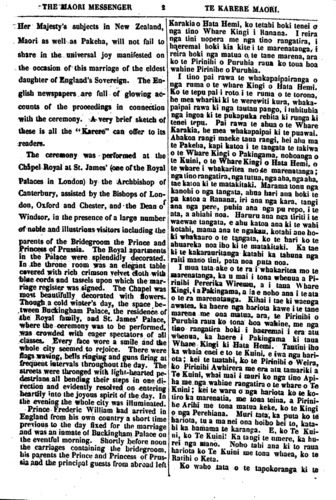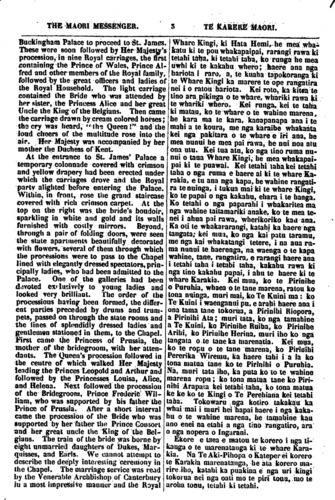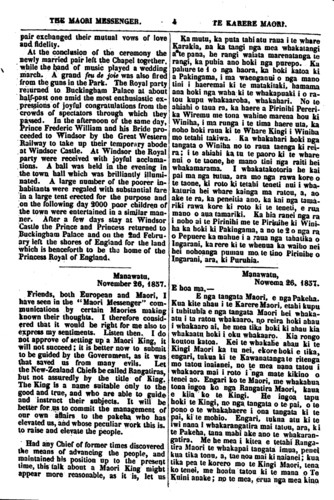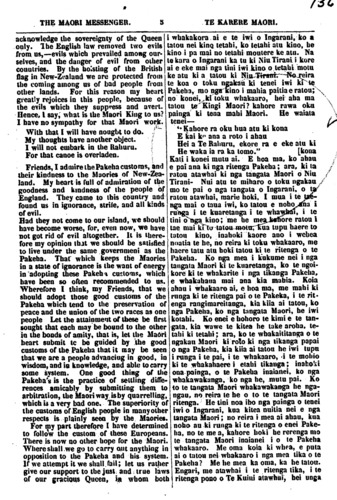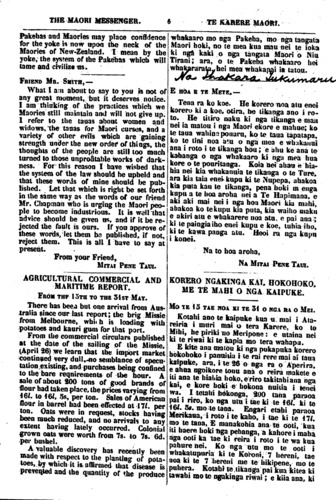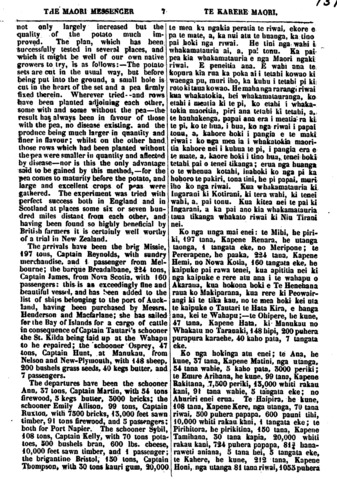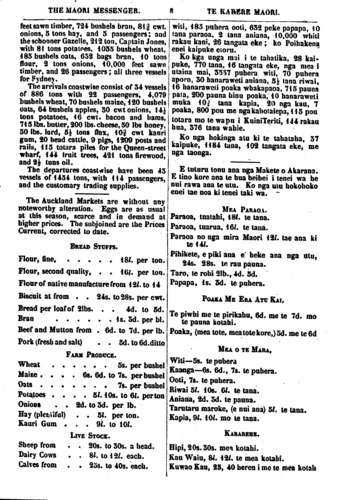 |
The Maori Messenger - Ko te Karere Maori 1855-1860: Volume 5, Number 11. 31 May 1858 |
 |
1 1 |
▲back to top |
THE MAORI MESSENGER. TE KARERE MAORI. VOL. V.] AUCKLAND, MAY 31, 1858. AKARANA, MEI 31, 1858. [No 11. THE MARRIAGE OF THE PRINCESS ROYAL. On the 25th January. of this year» an event look place in England, deeply interesting to the whole nation. A Royal marriage was celebrated. The Bridegroom, Prince Fred- eric William, is nephew to the reigning King of Prussia, and ia all probability, will one day himself ascend the throne of that kingdom. The youthful Bride is the Princess Royal of England, Victoria Ade- laide, eldest daughler of Queen Victoria and the Prince Consort, better known to the Maori people as Prince Albert. Her Royal Highness was born in 1840 and is therefore now in the 18th year of her age. TE MARENATANGA O TE TAMAHINE MATAMUA O TE KUINI. No TE 23 o nga ra o Hanuere, o tenei tau, ki tu te marenatanga o te tamahine o te Kuini, he ahuareka ki te iwi katoa taua mea he haringa ngakau hoki. Ko te tane marena. ko Pirinihi Pererika Wiremu, iramutu o te Kingi o Puruhia, a, ko ia ano hoki pea e eke ki te torona o taua whenua a muri ake nei. Ko te kotiro Pirinihe i marenatia, ko Wi- kitoria Atireira, ko te tamahine matamua o to tatou kuini raua ko tona hoa tane ko Pirinihi Arapata. No te tau 1840 i whanau ai tenei tamahine a te Kuini, ko te 18 tenei o ona tau. Ko nga tangata o te Kuini i Niu Tirani, ahakoa Pakeha ahakoa Maori, ka uru ano ki te tino haringa i hari ai te nga- kau o nga tangata katoa, mo te marenata- nga o te tamahine tuatahi o to Ingarani Kuini. Kapi kapi ana nga nupepa o Ingarangi i nga korero ahuareka noa iho 6 taua mare- natanga. He wahi iti ano te wahi e ahei te korero atu i tenei Karere hei titiro ma nga kai korero. I marenatia e te Akipihopa o Katepere ra- tou ko nga Pihopa o Ranana, o Okiwhara, o Hehita me te Rini o Winiha, ki te Whare
 |
2 2 |
▲back to top |
THE MAORI MESSENGER 2 TE KARERE MAORI. Her Majesty's subjects in New Zealand, Maori as well as Pakeha, will not fail to share in the universal joy manifested on the occasion of this marriage of the eldest daughter of England's Sovereign. The En- glish newspapers are full of glowing ac- counts of the proceedings in connection with the ceremony. A very brief sketch of these is all the " Karere" can offer to its readers. The ceremony was performed at the Chapel Royal at St. James' (one of the Royal Palaces in London) by the Archbishop of Canterbury, assisted by the Bishops of Lon- don, Oxford and Chester, and the Dean of Windsor, in the presence of a large number of noble and illustrious visitors including the parents of the Bridegroom the Prince and Princess of Prussia. The Royal apartments in the Palace were splendidly decorated. In Abe throne room was an elegant table covered with rich crimson velvet cloth with blue cords and tassels upon which the mar- riage register was signed. The Chapel was most beautifully decorated with flowers, Though a cold winter's day, the space be- , tween Buckingham Palace, the residence of the Royal family, and Sr. James' Palace, where the ceremony was to be performed. was crowded with eager spectators of all classes . Every face wore a smile and the whole city seemed to rejoice. There were flags waving, bells ringing and guns firing at frequent intervals throughout the day. The streets were thronged with light-hearted pe- destrians all bending their steps in one di- rection and evidently resolved on entering heartily into the joyous spirit of the day. In the evening the whole city was illuminated. Prince Frederic William had arrived in England from his own country a short time previous to the day fixed for the marriage and was an inmate of Buckingham Palace on the eventful morning. Shortly before noon the carriages containing the bridegroom, his parents the Prince and Princess of Prus- sia and the principal guests from abroad left Karakia o Hata Hemi, ko tetahi hoki tenei o nga tino Whare Kingi i Ranana. I reira nga tini nopera me nga tino rangatira, i haeremai hoki kia kite i te marenatanga , i reira hoki nga matua o, te tane marena, ara ko te Pirinihi o Puruhia raua ko toua hoa wahine Pirinihe o Puruhia. I tino pai rawa te whakapaipairanga o nga ruma o te whare Kingi o Hata Hemi . Ko te tepu pai i rota i te ruma o te torona, he mea whariki ki te werewiti kura, whaka- paipai rawa ki nga tautau pango, i tuhituhia nga ingoa ki te pukapuka rehita ki runga ki tenei tepu. Pai rawa te ahua o te Whare Karakia, be mea whakapaipai ki te puawai. Ahakoa rangi maeke taua rangi, hei aha ma te Pakeha, kapi katoa i te tangata te takiwa o te Whare Kingi o Pakingama, nohoanga o te Kuini, o te Whare Kingi o Hata Hemi, o te whare i whakaritea mo te marenatanga; nga tino rangatira, nga tuma, nga aha, nga aha, tae katoa ki te matakitaki. Marama tonu nga kanohi o nga tangata, ahua hari ana hoki te pa katoa a Ranana, iri ana nga kara tangi ana nga pere, puhia ana nga pu repo. i te ata, a ahiahi noa. Haruru ana nga a tiriti i te waewae tangata, e ahu katoa ana ki te wahi kotahi,mama ana te ngakau, kotahi ano ho- ki whakaaro o te tangata, ko te hari ko te ahuareka noa iho ki te matakitaki. Ka tae ki te kakarauritanga katahi ka tahuna nga raiti mano tini,, pata noa puta noa. I mua tata ake o te ra i whakaritea mo te marenatanga, ka u mai i tona whenua a Pi- rinihi Pererika Wiremu, a i taua Whare Kingi, i a Pakingama, a ia e noho ana i te ata o te ra marenatanga. Kihai i tae ki waenga awatea , ka haere nga hariota kawe ite tane marena me ona matua, ara, te Pirinihi o Puruhia raua ko tona hoa wahine, me nga tino rangatira hoki i haeremai i era atu whenua, ka haere i Pakingama ki taua Whare Kingi ki Hata Hemi. Tautini iho ka whaia enei e to te Kuini, e iwa nga hari- ota; kei te tuatahi, ko te Pinnihi o Weira, ko Pirinihi Awhirera me era atu tamariki a Te Kuini, whai mai i muri ko nga tino Api- ha me nga wahine rangatira o te whare o Te Kuini; kei te waru o nga hariota ko te ko- tiro ka marenatia, me tona teina, a Pirini- he Arihi me tona matua keke, ko te Kingi o nga Perehiana. Muri tata, ka puta ko te hariota, tu a ma nei ona hoiho hei to, kata- hi ka hamama te karanga . E, ko Te Kui- ni, ko Te Kuini! Ka tangi te umere, ka hu- i rei nga mano. Noho tahi ana ki to raua hariota ko Te Kuini me tona whaea, ko te Ratihi o Keta. Ko waho tata o te tapokoranga ki te
 |
3 3 |
▲back to top |
THE MAORI MESSENGER. TE KARERE MAORI. Buckingham Palace to proceed to St. James. These were soon followed by Her Majesty's procession, in nine Royal carriages, the first containing the Prince of Wales, Prince Al- fred and other members of the Royal family, followed by the great officers and ladies of the Royal Household, The light carriage contained the Bride who was attended by her sister, the Princess Alice and her great Uncle the King of the Belgians. Then came the carriage drawn by cream colored horses; the cry was heard, " the Queen !" and the loud cheers of the multitude rose into the air.Her Majesty was accompanied by her mother the Duchess of Kent. At the entrance to St. James' Palace a temporary colonnade covered with crimson and yellow drapery bad been erected under which the carriages drove and the Royal party alighted before entering the Palace. Within, in front, rose the grand staircase covered with rich crimson carpet. At the top on the right was. the bride's boudoir, sparkling in white and gold and its walls furnished with costly mirrors. Beyond, through a pair of folding doors, were seen the state apartments beautifully decorated with flowers, several of them through which Ihe processions were to pass to the Chapel lined with elegantly dressed spectators, prin- cipally ladies, who had been admitted to the Palace. One of. the galleries had been devoted exclusively to young ladies and looked very brilliant. The order of the processions having been formed, the differ- ent parties preceded by drums and trum- pets, passed on through the state rooms and the lines of splendidly dressed ladies and gentlemen stationed in them, to the Chapel. First came the Princess of Prussia, the mother of the bridegroom, with her atten- dants. The Queen's procession followed in the centre of which walked Her Majesty lending the Princes Leopold and Arthur and followed by the Princesses Louisa, Alice, and Helena. Next followed the procession of the Bridegroom, Prince Frederic Wil- liam, who was supported by his father the Prince of Prussia. After a short interval came the procession of the Bride who was supported by her father the Prince Consort and her great uncle the King of the Bel- gians. The train of the bride was borne by eight unmarried daughters of Dukes, Mar- quisses, and Earls. We cannot attempt to describe the deeply interesting ceremony in the Chapel. The marriage service was read by the Venerable Archbishop of Canterbury in a most impressive manner and the Royal Whare Kingi, ki Hata Hemi, he mea wha- katu ki te pou whakapaipai, rarangi rawa ki tetahi taha, hi tetahi taha. ko runga he mea uwhi ki te kakahu whero; haere ana nga hariota i raro, a, te kuaha tapokoranga ki te Whare Kingi ka marere te ope rangatira nei i o ratou hariota. Kei roto, ka kitea te tino ara pikinga o te whare, whariki rawa ki te whariki whero. Kei runga, kei te taha ki matau, ko te whare o te wahine marena, be kara ma te kara, kanapanapa ana i te mahia te koura, me nga karaihe whakaata kei nga pakitara o te whare e iri ana, he mea nunui be mea pai rawa, be nui hoa atu ona utu. Kei tua atu, ko nga tino ruma nu- nui o tana Whare Kingi, he mea whakapai- pai ki te puawai. Kei tetahi taha kei tetahi taha o nga ruma e haere ai ki te whare Ka- rakia, e tu ana nga kapa, he wahine rangati- ra te nuinga, i tukua mai ki te whare Kingi, ko te papai o nga kakahu, ehara i te hanga. Ko tetahi o nga paparahi i whakaritea ma nga wahine taitamariki anake, ko te mea te- nei i ahua pai rawa, wherikoriko kau ana. Ka oti te whakararangi, katahi ka haere nga tangata; kei mua, ko nga kai patu taramu, me nga kai whakatangi tetere, i na aua ru- ma nunui te haerenga, na waenga o te kapa wahine, tane, rangatira, e rarangi haere ana i tetahi taha i tetahi taha, kakahu rawa ki nga tino kakahu papai, i ahu te haere ki te whare Karakia. Kei mua, ko te Pirinihe o Puruhia. whaea o te tane marena, ratou ko tona nuinga, muri mai,. ko Te Kuini ma: ko Te Kuini i waenganui pu, e arahi haere ana i ona tama tane tokorua, a Pirinihi Riopora, a Pirinihi Ata; muri tata, ko nga tamahine a Te Kuini, ko Pirinihe Ruiha, ko Pirinihe Arihi, ko Pirinihe Herina, muri iho ko nga tangata o te tane ka marenatia. Kei mua, ko te ropu o te tane marena, ko Pirinihi Pererika Wiremu, ka haere tahi i a ia ko tona matua tane ko te Pirinihi o Puruhia. Na, muri tata iho, ka puta ko to te wahine marena ropu; ko tona matua tane ko Piri- nihi Arapata kei tetahi taha, ko tona matua ke ke ko te Kingi o Te Perehiana kei tetahi taha. Tokowaru nga kotiro takakau ka whai mai i muri hei hapai haere i nga kaka- hu o te wahine marena, he tamahine kau ano enei na etahi a nga tino rangatira, ara o nga nopera o Ingarani. Ekore e mea e matou te korero i nga ti- kanga o te marenatanga ki te whare Kara- kia. Na Te Aki-Pihopa o Kateperei korero te Karakia marenatanga, he ata korero ma- rire iho, katahi ka puakina e nga uri kingi tokorua hei nga oati mo te pin tonu, mo te aroha tonu, tetahi ki tetahi.
 |
4 4 |
▲back to top |
THE MAORI MESSENGER. TE KARERE MAORI. pair exchanged their mutual vows of love and fidelity. At the conclusion of the ceremony the newly married pair left the Chapel together. while the band of music played a wedding march. A grand feu de joie was also fired from the guns in the Park. The Royal party returned to. Buckingham Palace at about half-past one amid the most enthusiastic ex- pressions of joyful congratulations from the crowds of spectators through which they passed. In the afternoon of the same day, Prince Frederic William and his Bride pro- ceeded to Windsor by the Great Western Railway to take up their temporary abode at Windsor Castle. At Windsor the Royal party were received with joyful acclama- tions. A ball was held in the evening in the town hall which was brilliantly illumi- nated. A large number of the poorer in- habitants were regaled with substantial fare in a large tent erected for the purpose and on the following day 2000 poor children of the town were entertained in a similar man- ner. After a few days stay at Windsor Castle the Prince and Princess returned to Buckingham Palace and on the 2nd Febru- ary left the shores of England for the land which is henceforth to be the home of the Princess Royal of England. Manawatu, November 26, 1857. Friends, both European and Maori, have seen io the "Maori Messenger" com- munications by certain Maories making known their thoughts. I therefore consid- ered that it would be right for me also to I express my sentiments. Listen then. I do not approve of selling up a Maori King, it will not succeed; it is better now to submit to be guided by the Government, as it was that saved as from many evils. Let the New-Zealand Chiefs be called Rangatiras, but not assuredly by the title of King. The King is a name suitable only to the good and true, and who are able to guide and instruct their subjects. It will be better for us to commit the management of our own affairs to the pakeha who has elevated us, and whose peculiar work this is. to raise and elevate the people. Had any Chief of former times discovered the means of advancing the people, and maintained bis position up to the present lime, this talk about a Maori King might appear more reasonable, as it is, let us Ka mutu, ka puta tahi atu raua i te whare Karakia, oa ka tangi nga mea whakatangi a te pana, he rangi waiata marenatanga te rangi, ka puhia ano hoki nga purepo. Ka pahure te 1 o nga haora, ka hoki katoa ki a Pakingama, i ma waenganui o nga mano tini i haeremai ki te matakitaki, hamama ana hoki nga waha ki te whakapuaki i o ra- tou kupu whakaaroha, whakahari. No te ahiahi o taua ra, ka haere a Pirinihi Pereri- ka Wiremu me tona wahine marena hou ki Winiha, i ma runga i te tima haere uta, ka noho hoki raua ki te Whare Kingi i Winiha mo tetahi takiwa. Ka whakahari hoki nga tangata o Winiha no to raua taenga ki rei- ra; i te ahiahi ka tu te paoro ki te whare nui o te taone, he mano tioi nga raiti hei whakamarama. I whakatakotoria he kai pai ma nga tutua, ara mo nga rawa kore o te taone, ki roto ki tetahi teneti nui i wha- katuria hei whare kainga ma ratou, a, ao ake te ra, ka peneitia ano, ka kai nga tama- riki rawa kore ki poto ki te teneti, e rua mano o aua tamariki. Ka hia ranei nga ra i noho ai te Pirinihi me te Pirinihe ki Wini- ha ka hoki ki Pakingama, a no te 2 o nga ra o Pepuere ka mahue i a raua nga tahatika o Ingarani, ka rere ki te whenua ka waiho nei hei nohoanga pumau ma te tino Pirinihe o Ingarani, ara, ki Puruhia. Manawatu, Nowema 26, 1857. E hoa ma,— E nga tangata Maori. e nga Pakeha. Kua kite ahau i te Karere Maori, etahi kupu i tuhituhia e nga tangata Maori hei whaka- atu i ta ratou whakaaro, no reira hoki ahau i whakaaro ai, he mea tika hoki ki ahau kia whakaatu hoki i oku whakaaro. Kia rongo koutou katoa. Kei te whakahe ahau ki te Kingi Maori ka tu nei, ekore hoki e tika, engari, tukua ki te Kawanatanga te ritenga mo tatou inaianei, no te mea nana tatou i whakaora mai i roto i nga mate kikino o tenei ao. Engari ko te Maori, me whakahua tona ingoa ko nga Rangatira Maori, kaua e kiia ko te Kingi. He ingoa tapu hoki te Kingi, no nga tangata o te pai, o te pono o te whakahaere i ona tangata ki te pai, ki te mohio. Engari, tukua atu ki te iwi nana i whakarangatira mai tatou, ara, ki te Pakeha, tana mahi ake ano te whakaran- gatira. Me he mea i kitea e tetahi Ranga- tira Maori te whakapai tangata imua, penei kua tika tono, a, tae noa mai ki naianei; kua tika pea te korero mo te Kingi Maori, tena ko tenei, me hoatu tatou ki te mana o Te 1 Kuini anake; no te mea, erua nga mea kino
 |
5 5 |
▲back to top |
THE MAORI MESSENGER. TE KARERE MAORI. acknowledge the sovereignty of the Queen only. The English law removed two evils from us,—evils which prevailed among our- selves, and the danger of evil from other countries. By the hoisting of the British flag in New Zealand we are protected from the coming among us of bad people from other lands. For this reason my heart greatly rejoices in this people, because of the evils which they suppress and avert. Hence, I say, what is the Maori King to us? I have no sympathy for that Maori work. With that I will have nought to do. My thoughts have another object. 1 will not embark in the Rahuru. For that canoe is overladen. Friends, I admire the Pakeha customs, and their kindness to the Maories of New Zea- land. My heart is full of admiration of the goodness and kindness of the people of England. They came to this country and found us in ignorance, strife, and all kinds of evil. Had they not come to our island, we should have become worse, for, even now, we have not got rid of evil altogether. It is there- fore my opinion that we should be satisfied to live under the same government as the Pakeha. That which keeps the Maories in a state of ignorance is the want of energy in adopting these Pakeha customs, which have been so often recommended to us. Wherefore I think, my Friends, that we should adopt those good customs of the Pakeha which tend to the preservation of peace and the union of the two races as one people Let the attainment of these be first sought that each may be bound to the other in the bonds of amity, that is, let the Maori heart submit to be guided by the good customs of the Pakeha that it may be seen that we are a people advancing in good, in wisdom, and in knowledge, and able to carry some system. One good thing of the Pakeha's is the practice of settling diffe- rences amicably by submitting them to arbitration, the Maori way is by quarrelling, which is a very bad one. The superiority of the customs of English people in many other respects is plainly seen by the Maories. For my part therefore I have determined to follow the custom of these Europeans. There is now no other hope for the Maori. Where shall, we go to carry out anything in opposition to the Pakeha and his system. If we attempt it we shall fail; let us rather give our support to the just: and - true laws of our gracious Queen, in whom both i whakakora ai e te iwi o Ingarani, ko a tatou nei kino tetahi, ko tetahi atu kino, be kino i pa mai no tetahi moutere ke atu. Na te kara o Ingarani ka tu ki Niu Tirani i kore ai e eke mai nga tini iwi kino o tetahi motu ke atu ki a tatou ki Niu, Tirani. No reira te koa o toku ngakau ki tenei iwi ki te Pakeha, mo nga kino i mahia paitia e ratou; no konei, ki toku whakaaro, hei aha ma tatou te Kingi Maori? kahore rawa oku painga ki tena mahi Maori. He waiata tenei— " Kahore ra oku hua atu ki kona E kai ko ana a roto i ahau Hei a Te Rahuru, ekore ra e eke atu ki He waka ia ra ka tomo." [kona Kati i konei mutu ai. E hoa ma, ko ahau e pai ana ki nga ritenga Pakeha; ara, ki ta ratou atawhai ki nga tangata Maori o Niu Tirani Nui atu te miharo o toku ngakau mo te pai o nga tangata o Ingarani. o ta ratou atawhai, marie hoki, I mua i te tae- nga mai o taua iwi, ko tatou e noho ana i runga i te kuaretanga i te whawhai, i te tini onga kino; me be me kahore ratou i tae mai ki to tatou motu, kua tupu haere to tatou kino, inahoki kaore ano i wehea noatia te be, no reira ki toku whakaaro, me haere tatu atu hoki tatou ki te ritenga o te Pakeha. Ko nga mea i kukume nei i nga tangata Maori ki te kuaretanga, ko te ngoi- kore ki te whakarite i nga tikanga Pakeha, e whakahaua mai ana kia mahia. Koia ahau i whakaaro ai, e hoa ma, me mahi ki runga ki te ritenga pai o te Pakeka, i te rit- enga rangimareitanga, kia kiia ai tatou, ko nga Pakeha, ko nga tangata Maori, he iwi kotahi. Ko enei e hohoro te kimi e te tan- gata. kia wawe te kitea he take aroha, te- tahi ki tetahi; ara, ko te whakaititanga o te ngakau Maori ki roto ki nga tikanga papai o nga Pakeha, kia kiia ai tatou he iwi tupu i runga i te pai, i te whakaaro, i te mohio ki te whakahaere i etahi tikanga; inahoki ona painga, o te Pakeha inaianei, ko nga whakawakanga, ko nga he, mutu pai. Ko to te tangata Maori whakawakanga he nga- ngau, no reira te he o to te tangata Maori ritenga. He tini noa iho nga painga o tenei iwi o Ingarani. kua kitea nuitia nei e nga tangata Maori; no reira i mea ai ahau, kua noho au ki runga ki te ritenga o enei Pake- ha, no te me a, kahore hoki be rerenga mo te tangata Maori inaianei i o te Pakeha whakaaro. Me oma koia ki whea, e puta ai o tatou nei whakaaro i nga mea tika o te Pakeha? Me he mea ka oma, ka he tatou. Engari, me atawhai i te ritenga tika, ite ritenga pono o Te Kuini atawhai, hei unga
 |
6 6 |
▲back to top |
THE MAORI MESSENGER. TE KARERE MAORI. Pakehas and Maories may place confidence for the yoke is now upon the neck of the Maories of New Zealand. I mean by the yoke, the system of the Pakehas which will tame and civilize us. FRIEND MR. SMITH,— What I am about to say to you is not of any great moment, but it deserves notice. I am thinking of ihe practices which we Maories still maintain and will not give up. I refer to the tauas about women and widows, the tauas for Maori curses, and a variety of other evils which are gaining strength under the new order of things, the thoughts of the people are still too much turned to those unprofitable works of dark- ness. For this reason I have wished that the system of the law should be upheld and that these words of mine should be pub- lished. Let that which is right be set forth in the same way as the words of our friend Mr. Chapman who is urging the Maori peo- ple to become industrious. It is well that advice should be given us and if it be re- jected the fault is ours. If you approve of these words, let them be published, if not, reject them. This is all I have to say at present. From your Friend, MITA! PENE TAUI. AGRICULTURAL COMMERCIAL AND MARITIME REPORT. FROM THE 15TH TO THE 31ST MAY. There has been but one arrival from Aus- tralia since our last report; the brig Missie from Melbourne, which is loading with potatoes and kauri gum for that port. From the commercial circulars published at the date of the sailing of the Missie, (April 26) we learn that the import market continued very dull no semblance of specu- lation existing, and purchases being confined to the bare requirements of the hour. A sale of about 200 tons of good brands of flour bad taken place, the prices varying from 161. to 161. 5s, per ton. Sales of American flour in barrel had been effected at 171. per ton. Oats were in request. Blocks having been much reduced, and no arrivals to any extent having lately occurred. Colonial grown oats were worth from 7s. to 7s. 6d. per bushel. A valuable discovery has recently been made with respect to the planting of pota- toes, by which it is affirmed that disease is prevented and the quantity of the produce whakaaro mo nga Pakeha, mo nga tangata Maori hoki, no te mea kua mau nei te ioka ki nga kaki o nga tangata Maori o Niu Tirani; ara, o te Pakeha whakaaro hei whakararata, hei mea whakapai ia tatou. E HOA E TE METE.— Tena ra ko koe. He korero noa atu enei korero ki a koe, otira, he tikanga ano i ro- to. He titiro naku ki nga tikanga e mau nei ia matou i nga Maori ekore e mahue; ko te taua wahine pouaru, ko te taua tapatapa, ko te tihi noa atu o nga mea e whakanui ana i roto i te tikanga hou; e ahu ke ana te kahanga o nga whakaaro ki ngu mea hua kore o te pouritanga. Koia nei ahau e hia- hia nei kia whakanuia te tikanga o te Ture, ara kia taia enei kupu ki te Nupepa, ahakoa kia puta kau Ie tikanga» pena hoki me nga kupu a te boa aroha nei a Te Hapimana, e aki aki mai nei i nga hoa Maori kiu mahi, ahakoa ko te kupu kia puta, kia waiho maku e akiri atu e whakarere noa atu. e pai ana; ki te paingia iho enei kupu e koe, tuhia iho, ki te kawa panga atu. Heoi ra nga kupu i konei. Na to boa aroha. NA MITAI PENE TAUI. KORERO NGAKINGA KAI HOKOHOKO, ME TE MAHI O NGA KAIPUKE. MO TE 15 TAE N0A KI TE 51 O NGA RA O MEI. Kotahi ano te kaipuke kua u mai i Ata- reiria i muri mai o tera Karere, ko to Mihi, he piriki no Meripone: e utaina nei ki te ri wai ki te kapia mo tera wahapu. E kite ana matou ki nga pukapuka korero hokohoko i panuitia i te rai rere mai ai taua kaipuke, ara. i te 26 o nga ra o Aperira. e ahua ngoikore tonu ana o reira makete e iti ana te hiahia hoko, e riro takitahi ana nga kai, e kore hoki e hokona nuitia i tenei wa. I tetahi hokonga, 300 taha paraoa pai i riro, ko nga utu i tae ki te 161. ki te 161. 5. mo te tana. Engari etahi paraoa Merikaua, i roto i te kaho, i tae ki te 171. mo te tana, E manakohia aha te ooti, kua iti haere hoki nga pehanga, a kahore i maha nga ooti ka tae ki reira i roto i te wa kua pahure nei. Ko nga utu mo te ooti i whakatupuria ki te Koroni, 7 hereni, tae noa ki te 7 hereni me te hikipene, mo te puhera. Kotahi te tikanga pai kua kitea ki tawahi mote ngakinga riwai; e kiia ana, ki
 |
7 7 |
▲back to top |
THE MAORI MESSENGER TE KARERE MAORI, not only largely increased but the quality of the potato much im- proved. The plan, which has been successfully tested in several places, and which it might be well of our own native growers to try, is as follows: The potato sets are cut in the usual way, but before being put into the ground, a small hole is cut in the heart of the set and a pea firmly fixed therein. Wherever tried and rows have been planted adjoining each other, some with and some without the pea—the result has, always been in favour of those with the pea, no disease existing, and the produce being much larger in quantity and finer in fllavour; whilst on the other hand. those rows which had been planted without the pea were smaller in quantity and affected by disease—nor is this the only advantage said to be gained by this method,—for the pea comes to maturity before the potato, and large and excellent crops of peas were gathered. The experiment was tried with perfect success both in England and in Scotland at places some six or seven hun- dred miles distant from each other, and having been found so highly beneficial by British farmers it is certainly well worthy of a trial in New Zealand. The arrivals have been the brig Missie, 197 tons, Captain Reynolds, with sundry merchandise, and 1 passenger from Mel- bourne; the barque Breadalbane, 224 tons, Captain James, from Nova Scotia, with 160 passengers: this is an exceedingly fine and beautiful vessel, and has been added to the list of ships belonging to the port of Auck- land, having been purchased by Messrs. Henderson and Macfarlane; she has sailed for the Bay of Islands for a cargo of cattle in consequence of Captain Tautari's schooner the St. Kilda being laid up at the Wahapu to he repaired; the schooner Osprey, 47 tons, Captain Hunt, at Manukau, from Nelson and New-Plymouth, with 148 sheep, 200 bushels grass seeds, 40 kegs butter, and 7 passengers. The departures have been the schooner Ann, 57 tons, Captain Martin, with 54 tons firewood, 5 kegs butter, 5000 bricks; the schooner Emily Allison, 99 tons, Captain Ruxton, with 7500 bricks, 13, 000 feet sawn timber, 91 tons firewood, and 5 passengers: both for Port Napier The schooner Sybil, 108 tons, Captain Kelly, with 70 tons pota- toes. 500 bushels bran, 600 Ibs. cheese, 10, 000 feet sawn timber, and 1 passenger; the brigantine Bristol, 150 tons, Captain Thompson, with 30 tons kauri gum, 90, 000 te mea ka ngakia peratia te riwai, ekore e pa te mate, a, ka nui atu te huanga, ka tino pai hoki nga riwai. He tini nga wahi i whakamatauria ai, a, pa! tonu. Ka pai pea kia whakamatauria e nga Maori ngaki riwai. E peneitia ana. E wahi ana te kopura kia rua ka poka ai i tetahi kowao ki waenga pu, muri iho, ka kuhu i tetahi pi ki; roto ki taua kowao. He maha nga rarangi riwai kua whakatokia, hei whakamatauranga, ko etahi i meatia ki Ie pi, ko etahi i whaka- tokia maoritia, piri ana tetahi ki tetahi, a, te hauhakenga, papai ana era i meatia ra ki te pi, ko te hua, i hua, ko nga riwai i papai tonu, a, kahore hoki i pangia e te maki riwai: ko nga mea ia i whakatokia maori- tia kahore nei i kuhua te pi, i pangia era e te mate, a, kaore hoki i tino hua, tenei hoki tetahi, pai o tenei tikanga; erua nga huanga o te whenua kotahi, inahoki ko nga pi ka hohoro te pakiri, tona tini, he pi papai, muri iho ko nga riwai. Kua whakamatauria ki, Ingarani ki Kotirani. ki tera wahi, ki tenei wahi, a, pai tonu. Kua kitea nei te pai ki Ingarani, a ka pai ano kia whakamatauria taua tikanga whakato riwai ki Niu Tirani nei. Ko nga unga mai enei: te Mihi, be piri- ki, 197 tana, Kapene Renara, be utanga taonga, 1 tangata eke, no Meripone; te Pererapene, he paaka, 224 tana, Kapene Hemi, no Nowa Kotia, 160 tangata eke, he kaipuke pai rawa tenei, kua apititia nei ki nga kaipuke e rere atu ana i te wahapu o Akarana, kua hokona hoki e Te Henehana raua ko Makiparana, kua rere ki Peowair- angi ki te tika kau» no te mea hoki kei uta te kaipuke o Tautari te Hata Kira, e hanga ana, kei te Wahapu;—te Ohipere, be kune, 47 tana» Kapene Hata, ki Manukau no Whakatu no Taranaki, 148 hipi, 200 puhera purapura karaehe, 40 kaho pata, 7 tangata eke. Ko nga hokinga atu enei; te Ana, he kune, 57 iana, Kapene Matini, nga utanga, 54 tana wahie, 5 kaho pata, 5000 periki; te Emire Arihana, he kune, 99 tana, Kapene Rakitana, .7, 500 periki, i 5, 000 whiti rakau kani, 91 tana wahie, 5 tangata eke; no Ahuriri enei erua. Te Haipira, he kune, 108 tana, Kapene Kere, nga utanga, 70 tana riwai, 500 puhera papapa, 600 pauni tihi, 10, 000 whiti rakau kani, 1 tangata eke; te Pirihitora. be pirikitina, 160 Iana, Kapene Tamihana, 50 tana kapia, 20, 000 whiti rakau kani, 724 puhera papapa, 81 ¾ hana- raweti aniana, 5 tana hei, 5 tangata eke, te Kahere, he kune, 212 tana, Kapene Honi, nga utanga 81 tana riwai, 1055 puhera
 |
8 8 |
▲back to top |
THE MAORI MESSENGER. 8 TE KARERE MAORI. feet sawn timber, 724 bushels bran, 81 ¾ cwt. onions, 5 tons hay, and 5 passengers; and the schooner Gazelle, 212 ton, Captain Jones, with 81 tons potatoes, 1055 bushels wheat, 185 bushels oats, 632 bags bran, 10 tons flour, 2 tons onions, 10, 000 feet sawn timber, and 26 passengers; all three vessels for Sydney. The arrivals coastwise consist of 54 vessels of 886 tons with 22 passengers, 4, 079 bushels wheat, 70 bushels maize, 120 bushels oats, 64 bushels apples, 50 cwt onions, 14½, tons potatoes, 46 cwt, bacon and hams, 715 Ibs. butter, 200 Ibs. cheese, 50 Ibs honey, 50 Ibs. lard, 5½ tons flax, 10¾ cwt kauri gum, SO bead cattle, 9 pigs, 1209 posts and rails, i i 5 totara piles for the Queen-street wharf, 144 fruit trees, 421 tons firewood, and 2½ tuns oil. The departures coastwise have been 45 vessels of 1454 tons, with 114 passengers, and the customary trading supplies. The Auckland Markets are without any noteworthy alteration. Eggs are as usual at this season, scarce and in demand at higher prices. The subjoined are the Prices Current, corrected to date. BREAD STUFFS. Flour, fine, . . . . . 181. per ton. Flour, second quality, . 161 per ton. Flour of native manufacture from 121. 14 Biscuit at from . 24s. to 28s per cwt. Bread per loaf of 21bs. 4d. to 5d. Bran . . . 1s. 3d. per bl. Beef and Mutton from 6d. to 7d. per Ib. Pork (fresh and salt) . . 5d.to6d.ditto FARM PRODUCE. Wheat ...... 5s. per bushel Maize . . . . 6s. 6d. to 7s per bushel Oats . 7s. per bushel Potatoes . . . . 5 1. 10s. to 61. per ton Onions . . . 2d. to 3d. per Ib. Hay (plentiful ) . . 51 per ton. Kauri Gum . . . 91. to 101 LIVE STOCK. Sheep from . . 20s. to 50s. a head. Dairy Cows . . 81. to 121. each. Calves from . . 25s. to 40s. each. witi, 185 puhera ooti, 652 peke papapa, 10 tana paraoa, 2 tana aniana, 10, 000 whiti rakau kani, 26 tangata eke; ko Poihakena enei kaipuke etoru. Ko nga unga mai i te tahatika, 28 kai - puke, 770 tana, 16 tangata eke, nga mea i utaina mai, 3557 puhera witi, 70 puhera aporo, 50 hanaraweti aniana, 5½ tana riwai, 16 hanaraweti poaka whakapaoa, 715 pauna pata, 200 pauna hinu poaka, 10 hanaraweti muka 10¾ tana kapia, 20 nga kau, 7 poaka, 800 pou me nga kaho taiepa, 115 pou totara mo te wa pu i Kuini Teriti, 144 rakau hua, 376 tana wahie. Ko nga hokinga atu ki te tahataha, 57 kaipuke, 1184 tana, 102 tangata eke, me nga taonga. E tuturu tonu ana nga Makete o Akarana. E tino kore ana te hua heihei i tenei wa he nui rawa ana te utu. Ko nga utu hokohoko enei tae noa ki tenei taki wa. MEA PARAOA. Paraoa. tuatahi, 181 te tana. Paraoa, tuarua, 161. te tana. Paraoa no nga mira Maori 121 tae ana ki te 141. Pihikete, e piki ana e heke ana nga utu, 24s. 28s. te rau pauna. Taro, te rohi 21b., 4d. 5d. Papapa, Is. 3d. te puhera. POAKA MB ERA ATU KAI, Te piwhi me te pirikahu, 6d. me te 7d. mo te pauna kotahi. Poaka, (mea tote, mea tote kore,) 5d. me te 6d MEA o TE MARA, Witi—5s. te puhera Kaanga—6s. 6d., 7s. te puhera. Ooti, 7s. te puhera. Riwai 51 10s. 61. te tana. Aniana, 2d. 3d. te pauna. Tarutaru maroke. (e nui ana) 51, te tana. Kapia, 91. 101. mo te tana. KARAREHE. Hipi, 20s. 50s. mea kotahi. Kau Waiu, 81. 121. te mea kotahi. Kuwao Kau, 25, 40 hereni i mo te mea kotahi





 loading...
loading... Commentary
Commentary